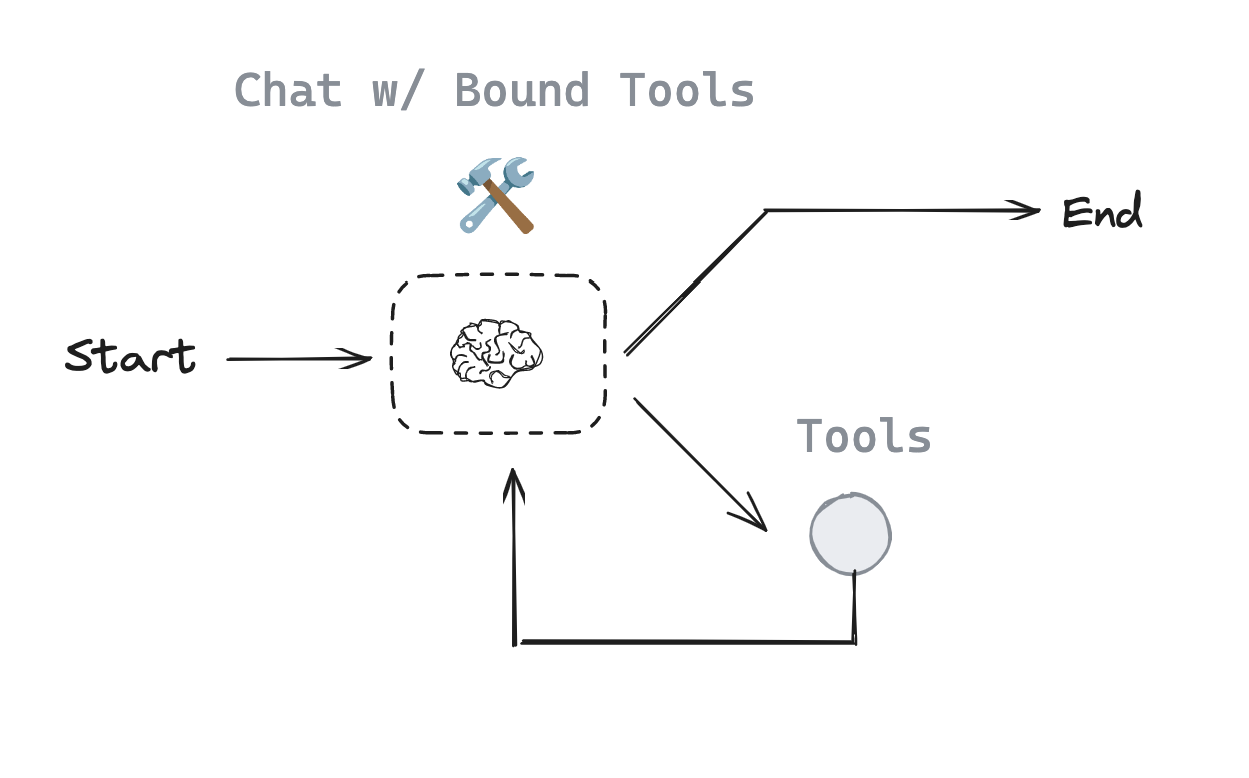In [ ]:
Copied!
%%capture --no-stderr
%pip install --quiet -U langchain_openai langchain_core langgraph langgraph-prebuilt
%%capture --no-stderr
%pip install --quiet -U langchain_openai langchain_core langgraph langgraph-prebuilt
In [1]:
Copied!
import os, getpass
def _set_env(var: str):
if not os.environ.get(var):
os.environ[var] = getpass.getpass(f"{var}: ")
_set_env("OPENAI_API_KEY")
import os, getpass
def _set_env(var: str):
if not os.environ.get(var):
os.environ[var] = getpass.getpass(f"{var}: ")
_set_env("OPENAI_API_KEY")
In [2]:
Copied!
_set_env("LANGSMITH_API_KEY")
os.environ["LANGSMITH_TRACING"] = "true"
os.environ["LANGSMITH_PROJECT"] = "langchain-academy"
_set_env("LANGSMITH_API_KEY")
os.environ["LANGSMITH_TRACING"] = "true"
os.environ["LANGSMITH_PROJECT"] = "langchain-academy"
这延续了我们之前的做法。
In [3]:
Copied!
from langchain_openai import ChatOpenAI
def multiply(a: int, b: int) -> int:
"""Multiply a and b.
Args:
a: first int
b: second int
"""
return a * b
# This will be a tool
def add(a: int, b: int) -> int:
"""Adds a and b.
Args:
a: first int
b: second int
"""
return a + b
def divide(a: int, b: int) -> float:
"""Divide a and b.
Args:
a: first int
b: second int
"""
return a / b
tools = [add, multiply, divide]
llm = ChatOpenAI(model="gpt-4o")
llm_with_tools = llm.bind_tools(tools)
from langchain_openai import ChatOpenAI
def multiply(a: int, b: int) -> int:
"""Multiply a and b.
Args:
a: first int
b: second int
"""
return a * b
# This will be a tool
def add(a: int, b: int) -> int:
"""Adds a and b.
Args:
a: first int
b: second int
"""
return a + b
def divide(a: int, b: int) -> float:
"""Divide a and b.
Args:
a: first int
b: second int
"""
return a / b
tools = [add, multiply, divide]
llm = ChatOpenAI(model="gpt-4o")
llm_with_tools = llm.bind_tools(tools)
In [4]:
Copied!
from langgraph.graph import MessagesState
from langchain_core.messages import HumanMessage, SystemMessage
# System message
sys_msg = SystemMessage(content="You are a helpful assistant tasked with performing arithmetic on a set of inputs.")
# Node
def assistant(state: MessagesState):
return {"messages": [llm_with_tools.invoke([sys_msg] + state["messages"])]}
from langgraph.graph import MessagesState
from langchain_core.messages import HumanMessage, SystemMessage
# System message
sys_msg = SystemMessage(content="You are a helpful assistant tasked with performing arithmetic on a set of inputs.")
# Node
def assistant(state: MessagesState):
return {"messages": [llm_with_tools.invoke([sys_msg] + state["messages"])]}
In [5]:
Copied!
from langgraph.graph import START, StateGraph
from langgraph.prebuilt import tools_condition, ToolNode
from IPython.display import Image, display
# Graph
builder = StateGraph(MessagesState)
# Define nodes: these do the work
builder.add_node("assistant", assistant)
builder.add_node("tools", ToolNode(tools))
# Define edges: these determine how the control flow moves
builder.add_edge(START, "assistant")
builder.add_conditional_edges(
"assistant",
# If the latest message (result) from assistant is a tool call -> tools_condition routes to tools
# If the latest message (result) from assistant is a not a tool call -> tools_condition routes to END
tools_condition,
)
builder.add_edge("tools", "assistant")
react_graph = builder.compile()
# Show
display(Image(react_graph.get_graph(xray=True).draw_mermaid_png()))
from langgraph.graph import START, StateGraph
from langgraph.prebuilt import tools_condition, ToolNode
from IPython.display import Image, display
# Graph
builder = StateGraph(MessagesState)
# Define nodes: these do the work
builder.add_node("assistant", assistant)
builder.add_node("tools", ToolNode(tools))
# Define edges: these determine how the control flow moves
builder.add_edge(START, "assistant")
builder.add_conditional_edges(
"assistant",
# If the latest message (result) from assistant is a tool call -> tools_condition routes to tools
# If the latest message (result) from assistant is a not a tool call -> tools_condition routes to END
tools_condition,
)
builder.add_edge("tools", "assistant")
react_graph = builder.compile()
# Show
display(Image(react_graph.get_graph(xray=True).draw_mermaid_png()))
内存¶
让我们像之前一样运行我们的代理程序。
In [6]:
Copied!
messages = [HumanMessage(content="Add 3 and 4.")]
messages = react_graph.invoke({"messages": messages})
for m in messages['messages']:
m.pretty_print()
messages = [HumanMessage(content="Add 3 and 4.")]
messages = react_graph.invoke({"messages": messages})
for m in messages['messages']:
m.pretty_print()
================================ Human Message ================================= Add 3 and 4. ================================== Ai Message ================================== Tool Calls: add (call_zZ4JPASfUinchT8wOqg9hCZO) Call ID: call_zZ4JPASfUinchT8wOqg9hCZO Args: a: 3 b: 4 ================================= Tool Message ================================= Name: add 7 ================================== Ai Message ================================== The sum of 3 and 4 is 7.
现在,让我们乘以 2!
In [7]:
Copied!
messages = [HumanMessage(content="Multiply that by 2.")]
messages = react_graph.invoke({"messages": messages})
for m in messages['messages']:
m.pretty_print()
messages = [HumanMessage(content="Multiply that by 2.")]
messages = react_graph.invoke({"messages": messages})
for m in messages['messages']:
m.pretty_print()
================================ Human Message ================================= Multiply that by 2. ================================== Ai Message ================================== Tool Calls: multiply (call_prnkuG7OYQtbrtVQmH2d3Nl7) Call ID: call_prnkuG7OYQtbrtVQmH2d3Nl7 Args: a: 2 b: 2 ================================= Tool Message ================================= Name: multiply 4 ================================== Ai Message ================================== The result of multiplying 2 by 2 is 4.
In [8]:
Copied!
from langgraph.checkpoint.memory import MemorySaver
memory = MemorySaver()
react_graph_memory = builder.compile(checkpointer=memory)
from langgraph.checkpoint.memory import MemorySaver
memory = MemorySaver()
react_graph_memory = builder.compile(checkpointer=memory)
使用内存时,我们需要指定一个 thread_id。
这个 thread_id 将存储我们的图状态集合。
以下是示意图:
- 检查点程序会在图的每个步骤写入状态
- 这些检查点保存在一个线程中
- 未来我们可以通过
thread_id访问该线程

In [9]:
Copied!
# Specify a thread
config = {"configurable": {"thread_id": "1"}}
# Specify an input
messages = [HumanMessage(content="Add 3 and 4.")]
# Run
messages = react_graph_memory.invoke({"messages": messages},config)
for m in messages['messages']:
m.pretty_print()
# Specify a thread
config = {"configurable": {"thread_id": "1"}}
# Specify an input
messages = [HumanMessage(content="Add 3 and 4.")]
# Run
messages = react_graph_memory.invoke({"messages": messages},config)
for m in messages['messages']:
m.pretty_print()
================================ Human Message ================================= Add 3 and 4. ================================== Ai Message ================================== Tool Calls: add (call_MSupVAgej4PShIZs7NXOE6En) Call ID: call_MSupVAgej4PShIZs7NXOE6En Args: a: 3 b: 4 ================================= Tool Message ================================= Name: add 7 ================================== Ai Message ================================== The sum of 3 and 4 is 7.
如果我们传递相同的 thread_id,就可以从之前记录的状态检查点继续执行!
在这种情况下,上述对话内容会被记录在该线程中。
我们传递的 HumanMessage("Multiply that by 2.")会追加到上述对话之后。
因此,模型现在知道 that 指的是 The sum of 3 and 4 is 7.。
In [10]:
Copied!
messages = [HumanMessage(content="Multiply that by 2.")]
messages = react_graph_memory.invoke({"messages": messages}, config)
for m in messages['messages']:
m.pretty_print()
messages = [HumanMessage(content="Multiply that by 2.")]
messages = react_graph_memory.invoke({"messages": messages}, config)
for m in messages['messages']:
m.pretty_print()
================================ Human Message ================================= Add 3 and 4. ================================== Ai Message ================================== Tool Calls: add (call_MSupVAgej4PShIZs7NXOE6En) Call ID: call_MSupVAgej4PShIZs7NXOE6En Args: a: 3 b: 4 ================================= Tool Message ================================= Name: add 7 ================================== Ai Message ================================== The sum of 3 and 4 is 7. ================================ Human Message ================================= Multiply that by 2. ================================== Ai Message ================================== Tool Calls: multiply (call_fWN7lnSZZm82tAg7RGeuWusO) Call ID: call_fWN7lnSZZm82tAg7RGeuWusO Args: a: 7 b: 2 ================================= Tool Message ================================= Name: multiply 14 ================================== Ai Message ================================== The result of multiplying 7 by 2 is 14.
In [ ]:
Copied!

